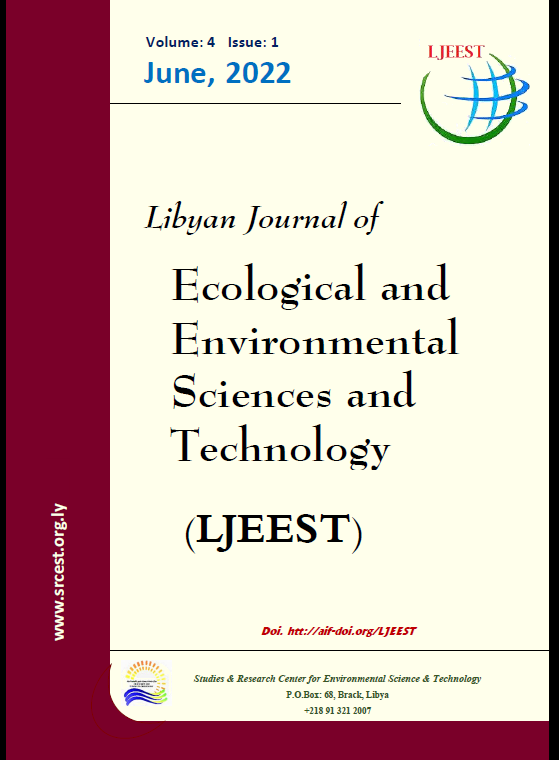Effect of Irrigation by Shallow and Deep Nubian Aquifer on Soil Properties and Crop Production in El-Kufra Oasis, Southern Libya
DOI:
https://doi.org/10.63359/2zk2dc37Keywords:
crop yield, groundwater, irrigation, private farms, soil properties, state farms.Abstract
El-Kufra oasis lies in southeastern Libya, deep in the Sahara Desert, covering an area of about 3,630 km2. Rainfall is deficient, and agriculture depends mainly on irrigation from groundwater (The Nubian aquifer). Most El-Kufra farms are private, using flood water irrigation from shallow wells (18‒55 m). The Kufra Agricultural Project (state farms) comprises 100 circles, using deep wells (220‒352 m). This study aimed to assess the quality of irrigation water from the shallow and deep aquifer in El-Kufra oasis and its effect on the soil properties and crop production (alfalfa and potato). According to the FAO classification system, 97% of the examined deep wells are suitable for irrigation, only 3% were in the slight to moderate restriction category (E.C.> 0.7 dS/m). However, 78% of the shallow wells were in the severe category degree (E.C.> 3 dS/m), and 22% were in the slight to the moderate category of restriction. The water quality is reflected in the soil properties and crop production. The soils of the state farms were in the normal range for pH, E.C., and ESP% values; meanwhile, 10% of the private farms were classified as saline-non alkali soil, and 70% as saline-alkali soils. The salt accumulation in the soil's root zone affects crop production, most obviously in the private farms as they depend on the shallow aquifer with poor water quality and use inappropriate irrigation and cultivation techniques. This study highlighted the urgent need to transfer the agricultural sector in El-Kufra district to depend on the deep aquifer and adjust the agricultural applications and cultivated crops to be more suitable for the desert environment and salty soils.
References
Abedi-Koupai, J., Mostafazadeh-Fard, B., Afyuni, M. and Bagheri, M.R. (2006). Effect of treated wastewater on soil chemical and physical properties in an arid region. Plant Soil and Environment, 52, 335-344
Al-Suhaibani, N.A. (2010). Estimation yield and quality of alfalfa and clover for mixture cropping pattern at different seeding rates. American-Eurasian of Journal Agriculture and Environmental Science, 8, 189-196.
APHA (1992). Standard methods for the examination of water and wastewater (16th ed). APHA, AWWA, and WPCF.
Ardahanlioglu, O., Oztasw, T., Evren, S., Yilmaz, H. and Yildirim, Z.N. (2003). Spatial variability of exchangeable sodium, electrical conductivity, soil pH, and boron content in salt- and sodium-affected areas of the Igdir plain (Turkey). Journal of Arid Environments, 54, 495-503.
Ayers, R. S., and Westcot, D. W. (1985). Water quality for agriculture. Rome: Food and Agriculture Organisation Irrigation and Drainage Paper.
Barber, S.A. (1995). Soil nutrient bioavailability; A mechanistic approach, Second Edition. New York: John Wiley & Sons.
Bhardwaj, A.K., Mandal, U.K., Bar-Tal, A., Gilboa, A. and Levy, G.J. (2008). Replacing saline-sodic irrigation water with treated wastewater: effects on saturated hydraulic conductivity. Irrigation Science, 26, 139-146.
Bravo-Garza, M.R. and Bryan, R.B. (2005). Soil properties along cultivation and fallow time sequences on vertisols in Northeastern Mexico. Soil Science Society of America Journal, 69, 473-481.
Cardoso, E. N., Vasconcellos, R. F., Bini, D., Miyauchi, M.Y.H., Santos, C. A., Alves, P.R.L., Monteiro de Paula, A., Nakatani, A. S., Pereira, J. M. and Nogueira, M. A. (2013). Soil health: looking for suitable indicators. What should be considered to assess the effects of use and management on soil health, Scientia Agricola, 70, 274-289.
Chapman, H. D., and Pratt, P. F. (1961). Methods of analysis for soils, plants, and waters. Riverside: University of California, Division of Agricultural Sciences.
Dregne, H. E. (1986). Physics of desertification. In: El-Baz, F. and Hassan, M.H.A. ed. Desertification of arid lands. Dordrecht: Springer Netherlands., pp 4-34.
Ellwood, M. S., and Hickes, J. R. (1991). Kufra agriculture project, water and soil survey. York: Yara Phosyn Ltd.
FAO, (2002). Crops and drops, making the best use of water for agriculture, publishing management service. Information division FAO. The land and water development division, FAO, Rome, Italy .//ftp.fao.org/agl/aglw/docs/cropsdrops_e.pdf
Flowers, T. J and Flowers, S. A (2005). Why does salinity pose such a difficult problem for plant breeders? Agricultural Water Management, 78, 15-24.
Gregorich, E. G., & Carter, M. R. (2007). Soil sampling and methods of analysis. Boca Ratan, FL: CRC Press.
Gros, R., Poulenard, J., Monrozier, L. J. and Faivre, P. (2006). Soil Physico-chemical changes following application of municipal solid waste leachates to grasslands. Water, Air and Soil Pollution, 169, 81- 100.
Henry, J. L., and Hogg, T. J. (2003). Irrigation sustainability–Saskatchewan activity. Outlook: Canada- Saskatchewan Irrigation Diversification Centre.
Khresat, S. A. and Taimeh, A. Y. (1998). Properties and characterisation of vertisols developed on limestone in a semiarid environment. Journal of Arid Environments, 40, 235-244.
Kinniburgh, D. G., and Smedley, P. L. eds (2001). Arsenic contamination of groundwater in Bangladesh, Volume 1 Summary W.C./00/19 Keyworth: British Geological Survey.
Lawgali, F. F. (2008). Forecasting water demand for agricultural, industrial, and domestic use in Libya. International Review of Business Research, 4, 231 – 248.
Laytimi, A. ed. (2002). Market and Trade Policies for Mediterranean Agriculture: The case of fruit/vegetable and olive oil, MEDFROL PROJECT, Agricultural Situation Report – Libya. Meknès: Department of Animal Production, Ecole Nationale d’Agriculture.
Loncnar, M., Zupancic, M., Bukovec, P. and Justin, M. Z. (2010). Fate of saline ions in a planted landfill site with leachate recirculation. Waste Management, 30, 110-118.
Loreto, F., Centritto, M. and Chartzoulakis, K. (2003). Photosynthetic limitations in olive cultivars with different sensitivity to salt stress. Plant, Cell and Environment, 26, 595-601.
Mostafazadeh-Fard, B., Heidarpour, M., Aghakhani, A. and Feizi, M. (2007). Effects of irrigation water salinity and leaching on soil chemical properties in an Arid Region. International Journal of Agriculture and Biology, 9, 466-469.
Munns, R. (2002). Comparative physiology of salt and water stress. Plant, Cell and Environment, 25, 239-250.
Munns, R. (2005). Genes and salt tolerance: bringing them together. New Phytologist, 167, 645-663.
National Engineering Handbook, Part 652 (1997). Natural Resources Conservation Service. Michigan United States Department of Agriculture, pp. 1-191.
Osman, A.E., Ibrahim, M. H. and Jones, M. A. eds. (1990). The role of legumes in the farming systems of the Mediterranean areas: Proceedings of a workshop on the role of legumes in the farming systems of the Mediterranean area. Berlin: Springer Science and Business Media. pp: 3-29.
Paliwal, K. V. and Gandhi, A. P. (1976). Effect of salinity, SAR, Ca: Mg ratio in irrigation water, and soil texture on the predictability of exchangeable sodium percentage. Soil Science, 122, 85-90.
Paranychianakis, N. V. and Chartzoulakis, K. S. (2005). Irrigation of Mediterranean crops with saline water, from physiology to management practices. Agriculture, Ecosystems and Environment, 106, 171-187.
Patel, R. M., Prasher, S. O., Donnelly, D. and Bonnell, R. B. (2001). Effect of initial soil salinity and sub irrigation water salinity on potato tuber yield and size. Agricultural Water Management, 46, 231-239.
Qiyan, F. and Baoping, H. (2002). Hydrogeochemical simulation of water-rock interaction under waterflood recovery in Renqiu Oil field, Hebei Province, China. Chinese Journal of Geochemistry, 21, 156-162.
Ragab, R. (2010). Preface: Salinity management in agriculture. In: Gheyi, H. R., Dias, N. D. and de Lacerda, C. F. eds. Salinity Management in Agriculture: Basic and Applied Studies. Fortaleza, Brazil. National Institute of Science and Technology in Salinity. pp. 1- 3.
Richards, L.A. (1954). United States salinity laboratory staff, diagnosis, and improvement of saline and alkali Soils. In: Allison, L. E., Brown, J. W., Hayward, H. E., Richards, L. A., Bernstein, L., Fireman, M., Pearson, G. A., Wilcox, L. V., Bower, C. A., Hatcher, J. T. And Reeve, R. C., eds. Soil and Water Conservation Research Branch, Agricultural Research Service. Washington, United States Department of Agriculture.
Robbins, C. W., and Carter, D. L. (1983). Selectivity coefficients for calcium- magnesium-sodium-potassium-exchange in eight soils. Irrigation Sciences, 4, 95-102.
Saaed, Manam W B (2018). Assessment of degradation and prospects of rehabilitation of the arid rangelands in the Tanqua Karoo region, South Africa, Tankwa Karoo National Park as a case study, Ph.D. thesis, Department of Conservation Ecology and Entomology, Faculty of AgriSciences, Stellenbosch University.
Shrivastava, P. and Kumar, R. (2015). Soil salinity: A serious environmental issue and plant growth promoting bacteria as one of the tools for its alleviation. Saudi Journal of Biological Sciences, 22, 123-131.
Subba Rao, M.V. and Muralikrishna, G. (2002). Evaluation of the antioxidant properties of free and bound phenolic acids from native and malted finger millet (Ragi, Eleusine coracana Indaf-15). Journal of Agricultural and Food Chemistry, 50, 889- 892.
Tanwir, F., Saboor, A. and Nawaz, N. (2003). Soil salinity and the livelihood strategies of small farmers: A case study in Faisalabad district, Punjab, Pakistan. International Journal of Agriculture and Biology, 5, 440-441.
Tarchitzky, J., Lerner, O., Shani, U., Arye, G., Lowengart-Aycicegi, A., Brener, A. and Chen, Y. (2007). Water distribution pattern in treated wastewater irrigated soils: hydrophobicity effect. European Journal of Soil Science, 58, 573-588.
Wallach, R., Ben-Arie, O. and Graber, E.R. (2005). Soil water repellency induced by long term irrigation with treated sewage effluent. Journal of Environmental Quality, 34, 1910- 1920.
Wang, Z., Chang, A.C., Wu, L., and Crowley, D. (2003). Assessing the soil quality of long term reclaimed wastewater-irrigated cropland. Geoderma, 114, 261-278.
Yousef, A. F. (1985). Soil and water resources of Taworgha Oasis. King Saud University Sciences. 7, 517-527.
Zheng, Y., Stute M., Van Geen A., Gavrieli I., Dhar, R., Simpson, H. J., Schlosser P. and Ahmed, K. M. (2004). Redox control of arsenic mobilisation in Bangladesh groundwater. Applied Geochemistry, 19, 201-214.
Zhu, J.K. (2001). Plant salt tolerance. Trends in Plant Science, 6, 66-71.
Published
Issue
Section
License
Copyright (c) 2025 Libyan Journal of Ecological & Environmental Sciences and Technology

This work is licensed under a Creative Commons Attribution-NonCommercial 4.0 International License.














